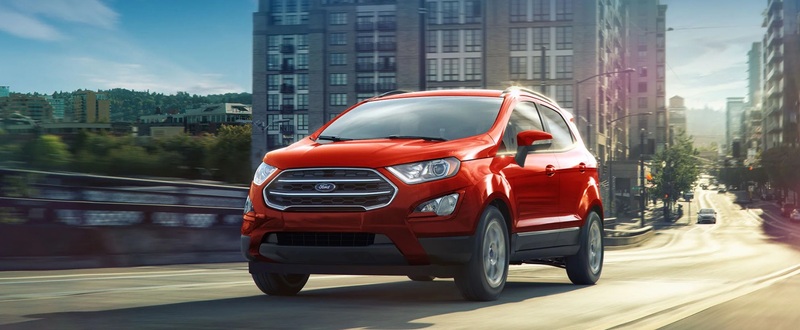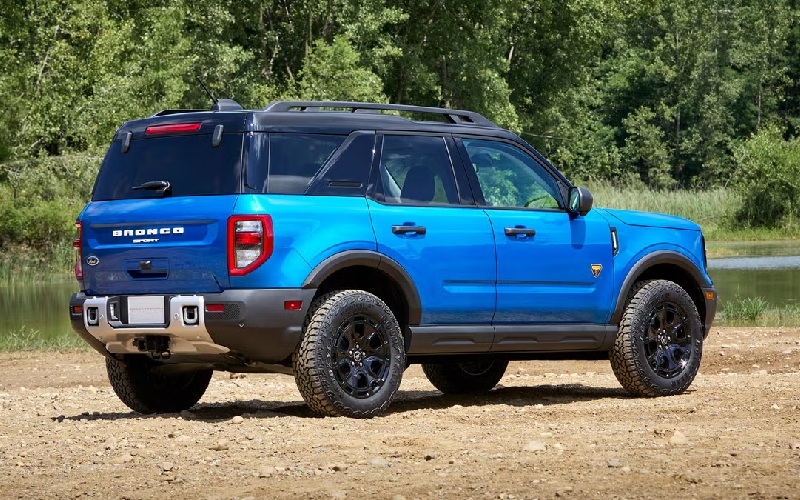The Evolution of Ford EcoSport Dimensions Across Generations
The Ford EcoSport has established itself as a notable contender in the subcompact crossover SUV segment since its initial launch in 2003. Over its nearly two-decade production run, this versatile vehicle underwent significant dimensional changes as it evolved through two generations. Introduction to the Ford EcoSport First introduced in Brazil in 2003, the Ford EcoSport […]
The Ford EcoSport has established itself as a notable contender in the subcompact crossover SUV segment since its initial launch in 2003. Over its nearly two-decade production run, this versatile vehicle underwent significant dimensional changes as it evolved through two generations.

Introduction to the Ford EcoSport
First introduced in Brazil in 2003, the Ford EcoSport was developed as a compact SUV aimed at emerging markets. The nameplate, pronounced “Eh-koh-sport,” combined “ecological” with “sport” to emphasize its dual nature as an environmentally conscious yet adventurous vehicle. Over time, the EcoSport expanded its global footprint, eventually reaching markets across South America, Asia, Europe, and North America in 2018.
Throughout its lifespan spanning two generations (2003-2012 and 2012-2022), the EcoSport maintained its position as a B-segment crossover SUV. However, its dimensions evolved significantly in response to changing market demands, regulatory requirements, and design philosophies.
First Generation (2003-2012): The Compact Pioneer
The first-generation Ford EcoSport (code: BV226) was built on the Ford B3 platform, shared with the fifth-generation Fiesta and European Fusion MPV. This foundation established the EcoSport as a compact offering in the emerging crossover segment.
Key Dimensions of the First Generation:
- Length: 4,228 mm
- Width: 1,980 mm (including mirrors)
- Height: 1,679 mm
- Wheelbase: 2,490 mm
These dimensions positioned the original EcoSport as a versatile urban vehicle with sufficient ground clearance for light off-road use. The relatively short wheelbase of 2,490 mm contributed to its agile handling characteristics, making it well-suited to navigating crowded city streets and tight parking spaces.
The substantial height of 1,679 mm provided excellent headroom and a commanding driving position – attributes that would become signature characteristics of the crossover segment. This generation’s proportions balanced compact exterior dimensions and practical interior space.
The first-generation EcoSport featured a distinctive side-hinged rear door with an externally mounted spare tire, a design choice that would continue into early versions of the second generation. This feature, while adding to the vehicle’s rugged SUV appearance, did impact its usable length measurement when considering parking scenarios.
Second Generation (2012-2022): Global Expansion
The second-generation Ford EcoSport (code: B515/BK) represented a significant evolution in the model’s design and dimensions. Developed under the Ford global product strategy, this iteration was built on the Global B-car Platform shared with the sixth-generation Fiesta.
Key Dimensions of the Second Generation:
- Length: 4,017 mm (global model), 3,998 mm (Indian market)
- Width: 1,765 mm (without mirrors), 2,057 mm (with mirrors)
- Height: 1,650 mm
- Wheelbase: 2,519 mm
- Ground Clearance: 200 mm
The second-generation EcoSport measured 4,017 mm in most markets (3,998 mm in India), making it approximately 211 mm shorter than its predecessor. Ford shortened the vehicle to improve maneuverability in crowded urban environments and to meet tax incentives in regions where vehicle length impacts taxation.
Despite the shorter overall length, Ford increased the wheelbase by 29 mm to 2,519 mm by using more efficient packaging and reducing front and rear overhangs. This design boosted interior space efficiency, especially for rear passengers who gained additional legroom. Ford also made the second generation narrower without mirrors (1,765 mm vs. 1,980 mm with mirrors for the first gen), which enhanced maneuverability without sacrificing interior shoulder room.
The height decreased slightly to 1,650 mm, a reduction of 29 mm compared to the first generation. This lower height improved aerodynamics and provided a more contemporary appearance while maintaining the elevated seating position favoured by crossover buyers.
A ground clearance of 200 mm remained impressive for the segment, allowing the EcoSport to maintain its off-road capabilities despite its increasingly urban focus.
Model Year Variations in the Second Generation
Throughout the second generation’s production run, the EcoSport received various updates and facelifts that occasionally altered its dimensions.
2014 Model:
- Length: 3,998 mm
- Width: 1,765 mm
- Height: Approximately 1,647 mm
- Wheelbase: 2,519 mm
- Boot Space: 333 liters
2016 Model:
- Length: 4,017 mm
- Width: 1,765 mm
- Height: Approximately 1,647 mm
- Wheelbase: 2,519 mm
- Boot Space: 333 liters
2018 Model (Post-Facelift):
- Length: 4,096 mm
- Width: 1,765 mm (without mirrors), 2,057 mm (with mirrors)
- Height: 1,653 mm
- Wheelbase: 2,519 mm
- Boot Space: 334 liters
- Ground Clearance: 160 mm
The 2018 facelift brought the most significant dimensional change to the second-generation EcoSport, with an increase in length of 79 mm compared to the 2016 model, bringing the total length to 4,096 mm. This change was primarily due to revised front and rear bumper designs that gave the vehicle a more substantial and modern appearance while improving crash protection.
Despite these changes in external dimensions throughout the second generation, the wheelbase remained constant at 2,519 mm, preserving the interior packaging efficiency established at the beginning of this generation’s lifecycle.
Interior Dimensions and Practical Space
Beyond the exterior measurements, the evolution of interior space utilization represents a critical aspect of the EcoSport dimensional development.
First Generation:
The first-generation EcoSport offered seating for five passengers, though rear accommodations were best suited for shorter journeys with three adults. Exact interior measurements are less well-documented for this generation, but the vehicle was known for providing adequate headroom thanks to its tall roof design.
Second Generation:
The second-generation model made more efficient use of its interior space despite the reduced exterior length:
- Seating Capacity: 5 persons
- Boot Space: Initially 333-334 liters, expanding to 352 liters in later models
- Maximum Boot Space (with rear seats folded): Approximately 1,238 liters
This generation featured a 60:40 split-folding rear seat arrangement, allowing for flexible cargo configurations. The boot opening, particularly in pre-facelift models with the side-hinged door, presented some loading challenges in tight parking situations. Later models addressed this with a more conventional top-hinged tailgate design in some markets.
Comparative Analysis Across Generations
When comparing the two generations directly, several dimensional trends become apparent:
- Wheelbase Extension: The increase from 2,490 mm to 2,519 mm (+29 mm) between generations prioritized interior space for passengers.
- Length Reduction Then Growth: The initial reduction in length from 4,228 mm to 4,017 mm (-211 mm) followed by incremental growth to 4,096 mm in later second-generation models reflects changing priorities from maximizing interior space efficiency to enhancing visual presence and crash protection.
- Height Reduction: The decrease from 1,679 mm to approximately 1,650 mm (-29 mm) demonstrated the evolution toward more aerodynamically efficient designs while maintaining the elevated driving position.
- Width Optimization: While direct comparison is challenging due to different measurement methods, the second generation appears to have been designed with a more efficient width profile, enhancing urban maneuverability.
- Boot Space Improvement: Despite the initially shorter overall length, the second-generation models ultimately offered larger cargo capacity (up to 352 liters vs. approximately 330 liters), demonstrating more efficient interior packaging.
The Impact of Dimensional Changes on Vehicle Characteristics
The dimensional evolution of the Ford EcoSport had significant implications for its overall character and performance:
Maneuverability and Parking
The second generation’s initially reduced length improved urban maneuverability, with a turning circle of approximately 10.6 meters. This advantage was slightly reduced with the 2018 facelift’s increased length, though the vehicle remained highly maneuverable for its class.
Interior Comfort
The increased wheelbase in the second generation improved rear passenger legroom, while the efficiently designed interior made better use of available space. The relatively high roof maintained excellent headroom despite the slight reduction in overall height.
Cargo Capacity
Despite dimensional fluctuations, practical cargo space increased over time, with later second-generation models offering up to 352 liters of boot space – competitive for the B-SUV segment.
Off-Road Capability
The maintained ground clearance of 200 mm (reduced to 160 mm in some markets/trims) preserved the EcoSport ability to handle moderate off-road conditions, though this was increasingly less emphasized in marketing as the vehicle evolved toward primarily urban use.
Aerodynamics
The second generation’s reduced height and more refined body contours improved aerodynamic efficiency, contributing to better fuel economy and reduced wind noise at highway speeds.
Regional Variations in Dimensions
Interestingly, the EcoSport dimensions weren’t uniform across all markets. The Indian-produced models were slightly shorter (3,998 mm) than those manufactured in other locations such as Brazil, Romania, and Thailand (4,017 mm). These variations reflected localized regulatory requirements, consumer preferences, and manufacturing considerations.
After the 2018 facelift, most markets received the longer 4,096 mm version, consistently standardizing the model’s global dimensions.
Tire Sizes and Their Influence on Dimensions
The EcoSport dimensions were also affected by its tire sizes, which varied across trim levels and generations:
First Generation:
- Base models: 205/65 R15
- Higher trims: 205/60 R16
Second Generation:
- Base models: 195/65 R15
- Higher trims: 215/60 R16
The larger wheel and tire combinations on higher trim levels effectively increased the vehicle’s ground clearance and overall height by a small margin. However, official dimension figures typically normalize these differences.
Ford EcoSport: Practicality and Contemporary Styling
The Ford EcoSport dimensional evolution across its two generations reflects broader trends in the crossover SUV market – from rugged, utilitarian designs toward more refined, urban-focused vehicles that balance practicality with contemporary styling.
The first generation established the model as a compact yet practical option with true SUV capabilities. In contrast, the second generation initially prioritized urban maneuverability before growing slightly to enhance presence and safety. The EcoSport maintained its fundamental character throughout these changes as a versatile, compact crossover that offered an elevated driving position, reasonable off-road capability, and practical interior space.
What’s particularly interesting is how Ford improved interior space efficiency despite the reduction in overall length between generations, demonstrating advances in packaging efficiency and design optimization. The eventual length increase with the 2018 facelift brought the model more in line with evolving consumer preferences for more substantial-looking crossovers without dramatically altering its essential proportions.
As the small crossover segment continues to evolve, the dimensional legacy of the EcoSport provides valuable insights into how manufacturers can balance competing priorities of interior space, exterior footprint, driving dynamics, and market positioning through careful dimensional engineering.



